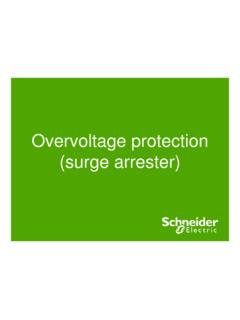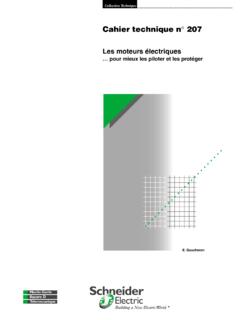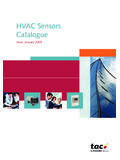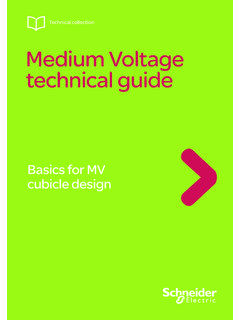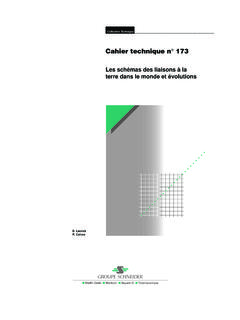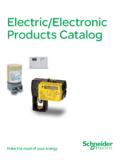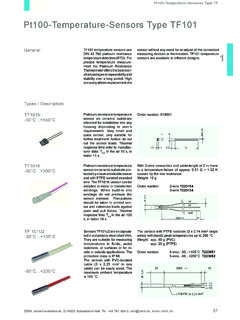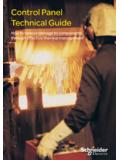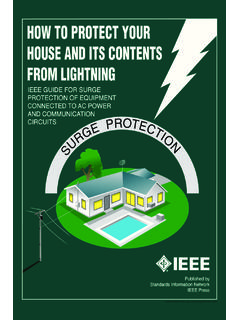Transcription of Surge protection devices SPD - Schneider Electric
1 Schneider Electric - Electrical installation guide 2015J - Overvoltage protectionJ10 Schneider Electric - all rights The Surge protection Device (SPD)The Surge protection Device (SPD) is a component of the electrical installation protection device is connected in parallel on the power supply circuit of the loads that it has to protect (see Fig. J17). It can also be used at all levels of the power supply network. This is the most commonly used and most efficient type of overvoltage protection . PrincipleSPD is designed to limit transient overvoltages of atmospheric origin and divert current waves to earth, so as to limit the amplitude of this overvoltage to a value that is not hazardous for the electrical installation and Electric switchgear and eliminates overvoltages:b in common mode, between phase and neutral or earth;b in differential mode, between phase and the event of an overvoltage exceeding the operating threshold, the SPD b conducts the energy to earth, in common mode.
2 B distributes the energy to the other live conductors, in differential mode. The three types of SPD:bType 1 SPDThe Type 1 SPD is recommended in the specific case of service-sector and industrial buildings, protected by a lightning protection system or a meshed protects electrical installations against direct lightning strokes. It can discharge the back-current from lightning spreading from the earth conductor to the network 1 SPD is characterized by a 10/350 s current 2 SPD The Type 2 SPD is the main protection system for all low voltage electrical installations.
3 Installed in each electrical switchboard, it prevents the spread of overvoltages in the electrical installations and protects the loads. Type 2 SPD is characterized by an 8/20 s current 3 SPD These SPDs have a low discharge capacity. They must therefore mandatorily be installed as a supplement to Type 2 SPD and in the vicinity of sensitive 3 SPD is characterized by a combination of voltage waves ( s) and current waves (8/20 s).Incomingcircuit breakerSPDL ightningcurrentSensitive loadsFig. J17 : Principle of protection system in parallelSurge protection devices (SPD) are used for Electric power supply networks, telephone networks, and communication and automatic control Electric - Electrical installation guide 2015J11 Schneider Electric - all rights reservedb Type 1 SPDvIimp: Impulse currentThis is the peak value of a current of 10/350 s waveform that the SPD is capable of discharging 5.
4 Autoextinguish follow current Applicable only to the spark gap is the current (50 Hz) that the SPD is capable of interrupting by itself after flashover. This current must always be greater than the prospective short-circuit current at the point of 2 SPDvImax: Maximum discharge currentThis is the peak value of a current of 8/20 s waveform that the SPD is capable of discharging once. bType 3 SPDv Uoc: Open-circuit voltage applied during class III (Type 3) of SPDI nternational standard IEC 61643-11 Edition (03/2011) defines the characteristics and tests for SPD connected to low voltage distribution systems (see Fig.)
5 J19). bCommon characteristicsv Uc: Maximum continuous operating voltageThis is the or voltage above which the SPD becomes active. This value is chosen according to the rated voltage and the system earthing Up: Voltage protection level (at In)This is the maximum voltage across the terminals of the SPD when it is active. This voltage is reached when the current flowing in the SPD is equal to In. The voltage protection level chosen must be below the overvoltage withstand capability of the loads (see section ).
6 In the event of lightning strokes, the voltage across the terminals of the SPD generally remains less than Up. v In: Nominal discharge current This is the peak value of a current of 8/20 s waveform that the SPD is capable of discharging 15 lightning strokeIndirect lightning strokeIEC 61643-1 Class I testClass II testClass III testIEC 61643-11/2007 Type 1:T1 Type 2 :T2 Type 3 :T3EN/IEC 61643-11 Type 1 Type 2 Type 3 Former VDE 0675vBCDNote 1: There existT1+T2 SPD (or Type 1 + 2 SPD) combining protection of loads against direct and indirect lightning 2:someT2 SPD can also be declared J18.
7 SPD standard definition InImax< 1 mAIUUpUcFig. J19 : Time/current characteristic of a SPD with varistorIn green, the guaranteed operating range of the Principle of lightning protectionb52& PQTOCVKXG FGsPKVKQPS chneider Electric - Electrical installation guide 2015J - Overvoltage protectionJ12 Schneider Electric - all rights reserved2 Principle of lightning applicationsb Low Voltage SPDVery different devices , from both a technological and usage viewpoint, are designated by this term. Low voltage SPDs are modular to be easily installed inside LV switchboards.
8 There are also SPDs adaptable to power sockets, but these devices have a low discharge SPD for communication networksThese devices protect telephon networks, switched networks and automatic control networks (bus) against overvoltages coming from outside (lightning) and those internal to the power supply network (polluting equipment, switchgear operation, etc.).Such SPDs are also installed in RJ11, RJ45, .. connectors or integrated into Electric - Electrical installation guide 2015J13 Schneider Electric - all rights reserved3 Design of the electricalinstallation protection Design rulesFor a power distribution system, the main characteristics used to define the lightning protection system and select a SPD to protect an electrical installation in a building are:b SPDv quantity of SPD; v type.
9 V level of exposure to define the SPD's maximum discharge current Short circuit protection devicev maximum discharge current Imax;v short-circuit current Isc at the point of logic diagram in the Figure J20 below illustrates this design the installation point ?Is there a lightning rodon the building or within50 metres of the building ?Type 1 + Type2orType 1+2 SPDR isks level ?Type2 SPDS urge Protective Device (SPD)Short CircuitProtection Device (SCPD)NoYesLow20 kAMedium40 kAHigh65 kAImax25 kA12,5 ?
10 Fig. J20 : Logic diagram for selection of a protection systemThe other characteristics for selection of a SPD are predefined for an electrical number of poles in SPD; b voltage protection level Up;b operating voltage sub-section J3 describes in greater detail the criteria for selection of the protection system according to the characteristics of the installation, the equipment to be protected and the protect an electrical installation in a building, simple rules apply for the choice of bSPD(s);bits protection - Overvoltage protectionSchneider Electric - Electrical installation guide 2015J14 Schneider Electric - all rights reservedJ - Overvoltage Elements of the protection Location and type of SPD The type of SPD to be installed at the origin of the installation depends on whether or not a lightning protection system is present.
